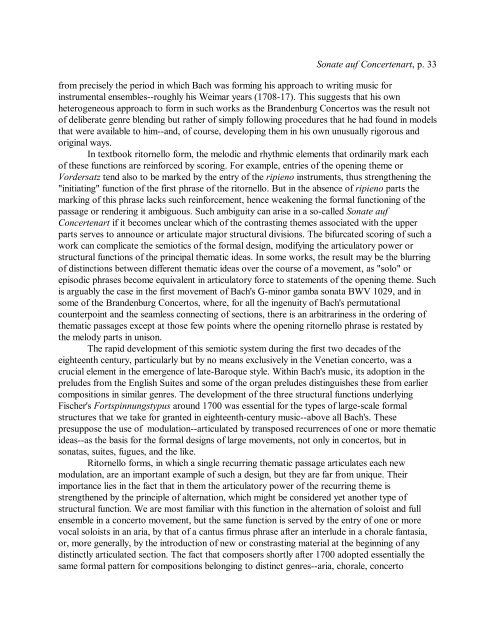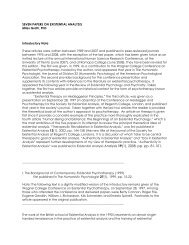The Sonate auf Concertenart: A Postmodern Invention? David ...
The Sonate auf Concertenart: A Postmodern Invention? David ...
The Sonate auf Concertenart: A Postmodern Invention? David ...
Create successful ePaper yourself
Turn your PDF publications into a flip-book with our unique Google optimized e-Paper software.
<strong>Sonate</strong> <strong>auf</strong> <strong>Concertenart</strong>, p. 33<br />
from precisely the period in which Bach was forming his approach to writing music for<br />
instrumental ensembles--roughly his Weimar years (1708-17). This suggests that his own<br />
heterogeneous approach to form in such works as the Brandenburg Concertos was the result not<br />
of deliberate genre blending but rather of simply following procedures that he had found in models<br />
that were available to him--and, of course, developing them in his own unusually rigorous and<br />
original ways.<br />
In textbook ritornello form, the melodic and rhythmic elements that ordinarily mark each<br />
of these functions are reinforced by scoring. For example, entries of the opening theme or<br />
Vordersatz tend also to be marked by the entry of the ripieno instruments, thus strengthening the<br />
"initiating" function of the first phrase of the ritornello. But in the absence of ripieno parts the<br />
marking of this phrase lacks such reinforcement, hence weakening the formal functioning of the<br />
passage or rendering it ambiguous. Such ambiguity can arise in a so-called <strong>Sonate</strong> <strong>auf</strong><br />
<strong>Concertenart</strong> if it becomes unclear which of the contrasting themes associated with the upper<br />
parts serves to announce or articulate major structural divisions. <strong>The</strong> bifurcated scoring of such a<br />
work can complicate the semiotics of the formal design, modifying the articulatory power or<br />
structural functions of the principal thematic ideas. In some works, the result may be the blurring<br />
of distinctions between different thematic ideas over the course of a movement, as "solo" or<br />
episodic phrases become equivalent in articulatory force to statements of the opening theme. Such<br />
is arguably the case in the first movement of Bach's G-minor gamba sonata BWV 1029, and in<br />
some of the Brandenburg Concertos, where, for all the ingenuity of Bach's permutational<br />
counterpoint and the seamless connecting of sections, there is an arbitrariness in the ordering of<br />
thematic passages except at those few points where the opening ritornello phrase is restated by<br />
the melody parts in unison.<br />
<strong>The</strong> rapid development of this semiotic system during the first two decades of the<br />
eighteenth century, particularly but by no means exclusively in the Venetian concerto, was a<br />
crucial element in the emergence of late-Baroque style. Within Bach's music, its adoption in the<br />
preludes from the English Suites and some of the organ preludes distinguishes these from earlier<br />
compositions in similar genres. <strong>The</strong> development of the three structural functions underlying<br />
Fischer's Fortspinnungstypus around 1700 was essential for the types of large-scale formal<br />
structures that we take for granted in eighteenth-century music--above all Bach's. <strong>The</strong>se<br />
presuppose the use of modulation--articulated by transposed recurrences of one or more thematic<br />
ideas--as the basis for the formal designs of large movements, not only in concertos, but in<br />
sonatas, suites, fugues, and the like.<br />
Ritornello forms, in which a single recurring thematic passage articulates each new<br />
modulation, are an important example of such a design, but they are far from unique. <strong>The</strong>ir<br />
importance lies in the fact that in them the articulatory power of the recurring theme is<br />
strengthened by the principle of alternation, which might be considered yet another type of<br />
structural function. We are most familiar with this function in the alternation of soloist and full<br />
ensemble in a concerto movement, but the same function is served by the entry of one or more<br />
vocal soloists in an aria, by that of a cantus firmus phrase after an interlude in a chorale fantasia,<br />
or, more generally, by the introduction of new or constrasting material at the beginning of any<br />
distinctly articulated section. <strong>The</strong> fact that composers shortly after 1700 adopted essentially the<br />
same formal pattern for compositions belonging to distinct genres--aria, chorale, concerto















